Germany Dental Equipment Market Outlook to 2030
By Product Cluster, By End User, By Technology Adoption, By Practice Size, and By Region
- Product Code: TDR0250
- Region: Europe
- Published on: August 2025
- Total Pages: 110
Introducing the World's FirstPay-Per-Section Market Reports
Why pay for the full report when you need just a part?
Start Building Your Report
Scroll down to see available sections
Report Summary
The report titled “Germany Dental Equipment Market Outlook to 2030 – By Product Cluster, By End User, By Technology Adoption, By Practice Size, and By Region” provides a comprehensive analysis of Germany’s dental equipment landscape. The study covers the overview and genesis of the industry, overall market size in revenue terms, and granular segmentation across product clusters. It assesses trends and developments, the regulatory framework, customer-level profiling, and issues & challenges. The competitive landscape details the competition scenario, an 8-parameter cross-comparison, and company profiling of major players. The report concludes with future projections based on installed-base upgrades, product shipments, and service contract penetration across regions, cause-and-effect relationships, and success case studies highlighting major opportunities and cautions.
Germany Dental Equipment Market Overview and Size
The Germany dental equipment market is valued at USD 680.5 million, grounded in data for 2023 and showing measurable expansion into 2024. This financial snapshot is sourced from a credible market study, reflecting the overall equipment revenue without estimates. Its growth is driven by increasing uptake of digital imaging technologies—such as CBCT, intraoral scanners—and ongoing investment in minimally invasive equipment, particularly in urban clinics.
The market is heavily concentrated in metropolitan centers such as Berlin, Munich, Hamburg and the Rhine‑Ruhr region, where high numbers of private practices, greater per-capita incomes, and advanced dental service organizations (DSOs) coexist. These areas benefit from stronger financing access and higher patient demand for cutting-edge technologies, making them clear anchors of market dominance.
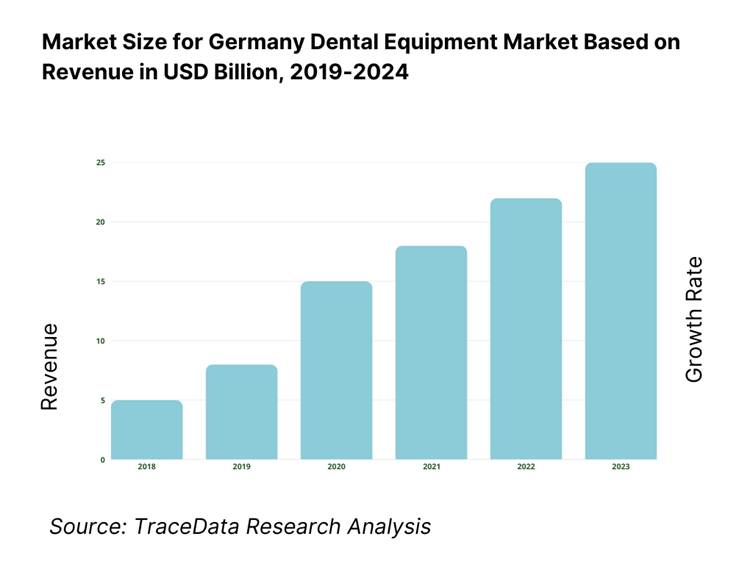
What Factors are Leading to the Growth of the Germany Dental Equipment Market:
Strong National Wealth and High Health Expenditure Per Capita: Germany’s nominal Gross Domestic Product stands at approximately USD 4.71 trillion, reflecting its position as the world’s third‑largest economy. In parallel, the average current health expenditure per person is about USD 1,407 in 2023. This high per-capita healthcare spending indicates ample capacity for dental clinics to invest in advanced equipment, such as CBCT units, CAD/CAM systems, and sterilization technologies. Clinics benefit from robust financing ecosystems—enabled by a strong economy—supporting ongoing equipment renewal and digital upgrades. Thus, macroeconomic wealth and health expenditure levels underpin dental equipment market expansion, enabling practices to modernize facilities to meet regulatory and patient-care expectations.
High Population and Aging Demographics Driving Dental Service Demand: Germany’s total population in late 2024 was around 83,577,140. The aging demographic—reflected in a low birth rate of 1.38 children per woman—indicates a growing elderly population requiring restorative, prosthetic, and diagnostic dental services. Additionally, Germany's population has been sustained by net immigration of 1.8 persons per 1,000 population in 2024. A larger elderly patient base and population stability raise demand for frequent dental interventions, fuelling clinic investments in imaging, sterilization, milling, and treatment units. This demographic context translates into continuous equipment replacement cycles and modernization—driving sustained demand momentum for dental technologies across the country’s private and institutional practices.
Well‑Developed Health Infrastructure and Skilled Workforce Availability: Germany spends about 3.1% of its GDP on research and development—a share higher than most peers—highlighting its capacity for adopting high‑tech equipment and innovation in healthcare delivery. Moreover, the country’s robust health infrastructure supports advanced practice environments capable of deploying digital dentistry workflows and integrating CAD/CAM, imaging, and instrument reprocessing systems. At the same time, unemployment is low at roughly 5.4% (2022) and total labor force exceeds 50 million, of which a significant share are health professionals. Affordable and accessible skilled labor—technicians, dental assistants, service engineers—ensures practices can utilize and maintain sophisticated equipment. This ecosystem of capability and support infrastructure underpins clinics’ willingness to adopt and upgrade dental equipment, ensuring both demand and effective utilization.
Which Industry Challenges Have Impacted the Growth of the Germany Dental Equipment Market:
Economic Contraction and Weak Equipment Investment Climate: Germany’s economy has contracted consecutively: −0.3% real GDP in 2023, followed by −0.2% in 2024. Specifically, in the second half of 2024, exports slipped 1.7%, crucial as export strength often correlates with broader investment sentiment. These macroeconomic headwinds imply constrained capital availability for discretionary healthcare spending, including expensive dental equipment. Clinics may delay upgrading to digital systems or postpone chair replacements. Lower investment appetite, driven by sluggish GDP and export declines, acts as a brake on the market, especially for higher‑ticket imaging systems and CAD/CAM infrastructure.
Fiscal Restraints from “Debt Brake” Limiting Public Sector Support: Germany’s constitutional "debt brake" requires the federal structural deficit to stay under 0.35% of GDP, while public debt remains at roughly 63% of GDP. Economists estimate the country could borrow up to €1.9 trillion more without harming growth. However, rigid fiscal constraints have limited public investment in healthcare infrastructure modernization. This affects university hospitals and public clinics’ ability to procure advanced dental equipment, placing more onus on private clinics and limiting overall market expansion. The lack of public funding support creates an uneven growth landscape, where smaller or public institutions lag in technology adoption, restraining market scale.
Industrial Downturn Suppressing Equipment Supply Chains: Germany’s industrial output has fallen over 10% since 2019, and around 350,000 manufacturing jobs have been lost in the same period. Given that many dental equipment components—or entire devices like compressors, milling units—are manufactured locally, industrial decline affects production capacity and supply chain stability. Manufacturing firms’ suppressed output and workforce layoffs may result in delays, higher lead times, or reduced innovation. Clinics may face difficulty sourcing equipment or parts, leading to slower adoption. This industrial fragility presents a systemic challenge impacting both supply reliability and introduction of new technologies in the dental equipment market.
What are the Regulations and Initiatives which have Governed the Market:
EU Medical Device Regulation (MDR) Implementation: The EU’s Medical Device Regulation (MDR) mandates conformity, requiring re-certification of many dental devices under stringent new standards. Germany, operating under MDR, must comply fully; facilities must document robust clinical evidence and risk management documentation for devices such as imaging systems or handpieces. MDR enforcement raises compliance costs and can extend time-to-market for new equipment models. Clinics and OEMs contend with increased regulatory documentation, mandatory post-market surveillance, and vigilance. These factors collectively slow novel product availability and elevate operational costs, affecting equipment turnover and modernization pace.
National Radiation Protection Licensing under StrlSchV: Germany’s Radiation Protection Ordinance (StrlSchV) regulates the use of X‑ray equipment like intraoral imaging and CBCT machines. Clinics must hold valid licenses, ensure personnel have Fachkunde (specialized training), and follow mandated testing protocols under the SV‑RL scheme. Licensing and maintenance costs—plus compliance with dose‑reduction protocols—impose significant burden on small practices. Before adopting advanced imaging, clinics must invest in training and facility upgrades. These licensing requirements, though essential for safety, slow adoption of imaging technology and raise barriers to equipment upgrades.
Hygiene and Sterilization Compliance Requirements (EN 13060 & KRINKO Guidelines): Germany enforces strict dental instrument reprocessing standards. Clinics must use Class B‑compliant autoclaves (per EN 13060 standard) and follow KRINKO‑BfArM hygiene guidelines, with documented cycle validation, maintenance logs, and staff training. Practices must maintain records and undergo inspections. Compliance demands regular equipment calibration, validation, and staff time. For OEMs, devices must be certified and supported with comprehensive documentation and service. This regulatory rigor ensures patient safety but increases operational overhead and slows equipment adoption in smaller practices.
Germany Dental Equipment Market Segmentation
By Product Type: In 2024, dental consumables dominate the product-type segmentation. This dominance stems from high procedural volume in restorative and prosthodontic care—aging demographics and preventive dentistry drive constant demand for implants, crowns, and biomaterials. Consumables are also lower ticket items compared to capital equipment, allowing broader adoption even in smaller practices, sustaining their share.
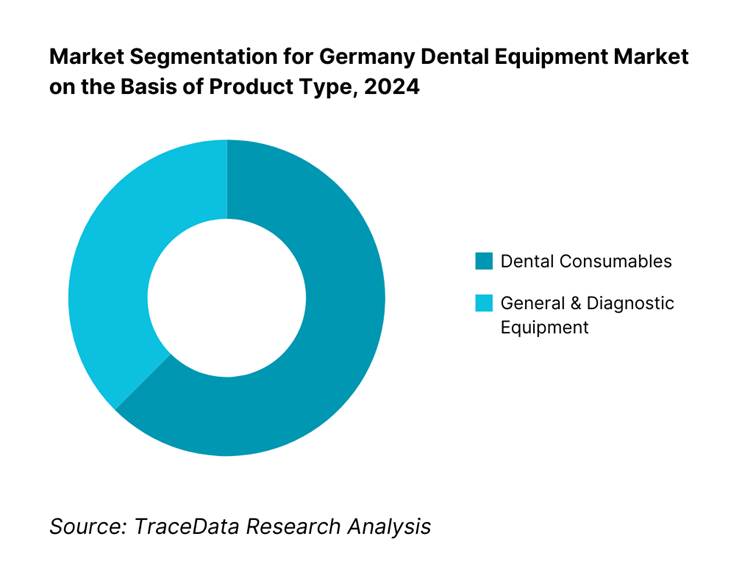
By End-User: Dental clinics, including DSOs, hold a dominant share because they account for the bulk of everyday dental procedures and are more agile in upgrading equipment to digital workflows. DSOs gain economies of scale via bundled hardware-software procurement, boosting adoption of advanced systems like CAD/CAM and intraoral scanning. Hospitals and academic institutions, while compelling, focus on specialized high-end imaging and research-grade tools, which account for a sizeable but smaller slice of the overarching market.
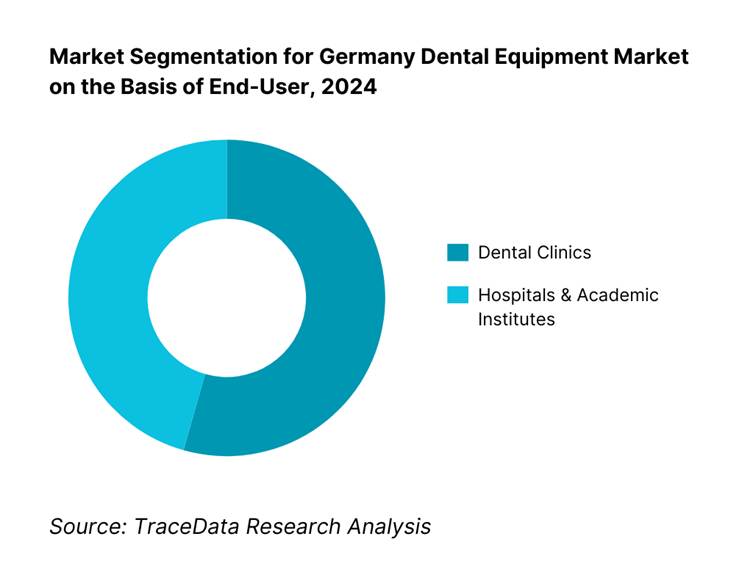
Competitive Landscape in Germany Dental Equipment Market
The German dental equipment market’s competitive landscape includes multinational giants such as Dentsply Sirona, 3M, Planmeca, Straumann, and Danaher (Nobel Biocare), alongside robust local players like Dürr Dental and VDW GmbH. This blend of global R&D-intensive firms and specialized domestic manufacturers ensures both cutting-edge offerings and localized service networks, solidifying the market’s innovation-driven but service-oriented structure.
Name | Founding Year | Original Headquarters |
Dentsply Sirona | 1899 | Charlotte, USA & Bensheim, Germany |
Dürr Dental | 1941 | Bietigheim-Bissingen, Germany |
KaVo Dental | 1909 | Berlin, Germany |
MELAG Medizintechnik | 1951 | Berlin, Germany |
BEGO | 1890 | Bremen, Germany |
vhf camfacture AG | 1988 | Ammerbuch, Germany |
Planmeca | 1971 | Helsinki, Finland |
W&H Dentalwerk | 1890 | Bürmoos, Austria |
ACTEON Group | 1946 | Mérignac, France |
Vatech | 1992 | Hwaseong, South Korea |
Carestream Dental | 2007 | Atlanta, USA |
3Shape | 2000 | Copenhagen, Denmark |
Align Technology | 1997 | Tempe, USA |
A-dec | 1964 | Newberg, USA |
Midmark | 1915 | Dayton, USA |
Some of the Recent Competitor Trends and Key Information About Competitors Include:
Dentsply Sirona: As one of the global leaders in dental equipment, Dentsply Sirona has expanded its digital dentistry portfolio in 2024, introducing upgraded intraoral scanners and chairside CAD/CAM systems at IDS Cologne, strengthening its presence in Germany’s premium practice segment.
Dürr Dental: Known for its innovation in imaging systems and dental compressors, Dürr Dental launched new CBCT imaging units with enhanced radiation dose optimization in 2024. The company also strengthened its infection-control solutions, aligning with strict German hygiene regulations.
KaVo Dental: With a strong historical base in Germany, KaVo Dental has focused on ergonomic treatment centers and digital integration. In 2024, it partnered with clinics and MVZ groups to promote fully digital operatories, enhancing chairside efficiency and workflow connectivity.
MELAG Medizintechnik: A leading sterilization equipment provider, MELAG introduced automated tracking software in 2024 to integrate autoclaves and washer-disinfectors with practice management systems, addressing growing demand for compliant instrument reprocessing solutions in German clinics.
BEGO: Specializing in dental laboratories and prosthetics, BEGO strengthened its 3D printing segment in 2024 by launching new resin-based materials for additive manufacturing, reflecting the rising adoption of digital lab workflows across Germany.
Planmeca: A strong competitor in imaging and treatment centers, Planmeca showcased new AI-assisted imaging tools at IDS Cologne in 2024, targeting large practices and academic institutions that require high diagnostic precision.
Align Technology: Best known for its Invisalign system and iTero scanners, Align Technology expanded its digital training and integration programs in 2024, focusing on orthodontic practices in Germany that are rapidly adopting aligner-based treatments.
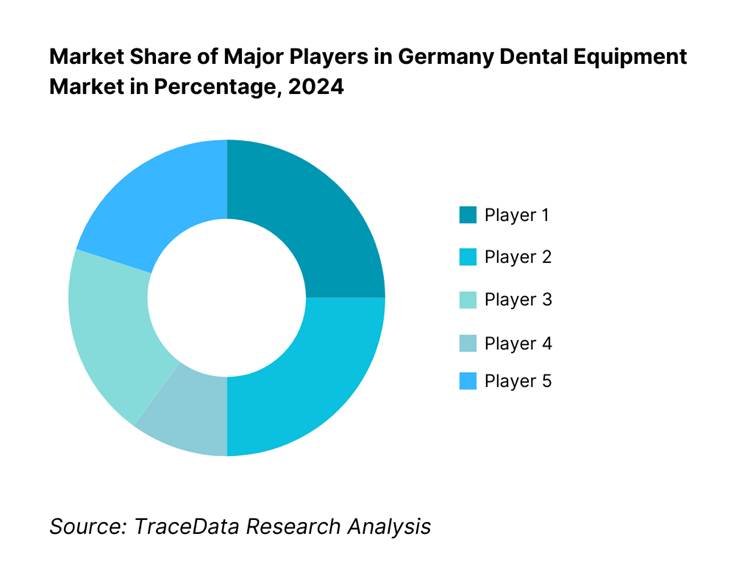
What Lies Ahead for Germany Dental Equipment Market?
The Germany dental equipment market is positioned for steady expansion through the next planning cycle, supported by the country’s high healthcare spend, dense clinic footprint, and rapid digitization of workflows. Growth will be underpinned by compliance-driven replacement (MDR, StrlSchV, KRINKO), aging-patient restorative demand, and MVZ (medical care center) consolidation that concentrates purchasing power. Expect a mid-to-high single-digit trajectory as practices upgrade imaging rooms, treatment centers, and instrument reprocessing lines while layering software, cloud, and AI across the operatory.
Digitally Unified, “Hybrid” Chairside–Lab Workflows: Dental practices in Germany are moving toward end-to-end digital pathways—scanning in the operatory, chairside design, in-house milling/3D printing, and selective outsourcing to laboratories for complex cases. This hybridization balances speed (same-day indications) with lab craftsmanship for advanced prosthetics. Interoperability with practice management systems, VDDS/DICOM standards, and TI/KIM connectivity will become table stakes, pushing upgrades to intraoral scanners, mills, and validated materials while raising demand for training, calibration, and quality assurance toolkits.
Outcome- and ROI-Driven Procurement: Purchasing committees in MVZs and larger group practices are tightening specifications around measurable outcomes: chair-time utilization, imaging throughput per hour, radiation dose metrics, sterilization cycle times, and service uptime SLAs. Vendors that demonstrate quantifiable improvements—shorter CBCT scan-to-diagnosis intervals, traceable instrument reprocessing compliant with EN 13060, automated waterline hygiene—will win framework agreements. Expect bundled hardware-software-service offers with predictive maintenance and guaranteed response windows to become standard.
Specialty Expansion Within Practices: General practices continue to internalize higher-value specialties—implantology, endodontics, orthodontics—requiring CBCT with variable FOV, surgical motors, guided surgery kits, and advanced endo systems. University hospitals and teaching centers will anchor premium imaging and research-grade equipment, but private clinics will drive volume as they add specialty operatories. This shifts the mix toward multi-indication platforms and training packages, increasing demand for manufacturer academies and certified courses.
AI-Enhanced Imaging, Automation, and Data Layer: AI will spread from pilot to routine use—lesion detection, nerve canal mapping, and treatment planning support—embedded in CBCT/2D suites and cloud platforms. Automation will extend to sterilization documentation, asset tracking, preventive maintenance, and consumable inventory. Cloud data layers will enable multi-site MVZ analytics, benchmarking device utilization and quality metrics, and tightening the feedback loop between clinical performance and capital planning.
Sustainability & Compliance as Catalysts: Germany’s strict hygiene and environmental rules—KRINKO-BfArM reprocessing guidance, EN 13060 Class B sterilization, and amalgam separator requirements—will keep pulling through compliant autoclaves, washer-disinfectors, and wastewater solutions. Energy-efficient compressors/suction, lower-dose imaging, and recyclable packaging will differentiate vendors in tenders. Expect sustainability reporting, take-back programs, and eco-design claims to influence procurement checklists alongside clinical performance.
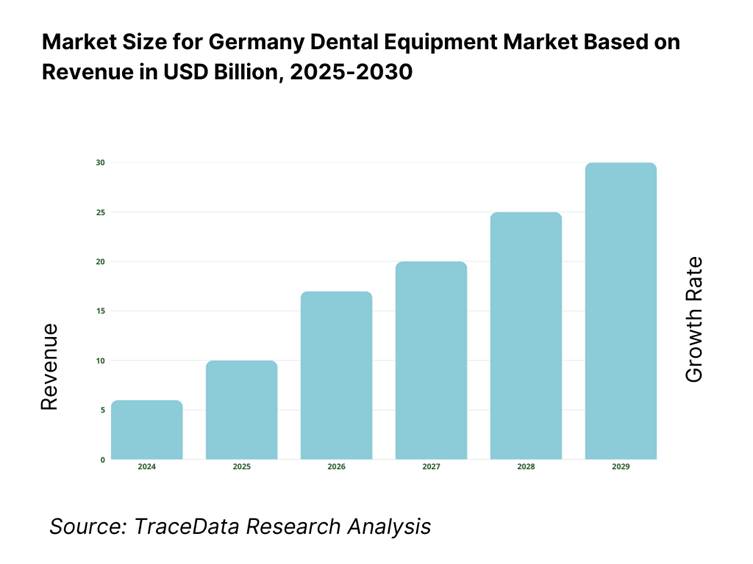
Germany Dental Equipment Market Segmentation
By Product Type
Treatment Centers & Delivery Systems
Diagnostic Imaging
CAD/CAM & Digital Dentistry
Sterilization & Reprocessing
Air & Suction Infrastructure
Surgical & Clinical Instruments (powered)
Lasers & Light-based Systems
IT & Software Stack
By End User
Independent dental practices (Einzelpraxis)
Group practices (BAG/Gemeinschaftspraxis)
MVZ/corporate clinic networks
University hospitals & teaching clinics
Public clinics/municipal centers
Dental laboratories (lab-only equipment lines)
By Procurement Channel
Depot/distributor-led (full-service)
Direct OEM (enterprise/MVZ frameworks)
Online B2B/e-commerce (equipment & accessories)
Public tenders (universities/hospitals)
Certified refurbished/remarketed
By Technology Adoption
Analog/basic digital (film/entry systems)
Semi-digital (mixed IOX + basic software)
Fully digital chairside (IOS + chairside CAD/CAM)
Lab-integrated digital (practice–lab workflows, 3D print)
AI-enabled/cloud-connected (decision support, remote QA, fleet analytics)
By Imaging Modality
Intraoral sensors/PSP
Panoramic OPG
Cephalometric
CBCT (≤8×8 cm; 8–12×12 cm; >12×12 cm FOV)
Hybrid platforms (2D/3D combo)
By Practice Size / Capacity
Micro (1–2 chairs)
Small (3–4 chairs)
Medium (5–7 chairs)
Large (8–10 chairs)
Extra-large/multi-site (>10 chairs across sites)
By Region
North Rhine-Westphalia (Ruhr/Rhine)
Bavaria (Munich metro and South)
Baden-Württemberg (Stuttgart/Upper Rhine)
Berlin-Brandenburg
Hamburg & Schleswig-Holstein
Hesse (Frankfurt/Rhine-Main)
Lower Saxony & Bremen
Saxony / Saxony-Anhalt / Thuringia
Rhineland-Palatinate & Saarland
Players Mentioned in the Report:
Dentsply Sirona
3M
Planmeca
Straumann
Danaher (Nobel Biocare)
Dürr Dental
KaVo Dental
Anton Gerl GmbH
VDW GmbH
GC Corporation
A-dec
Carestream Dental
vhf camfacture AG
Biolase
Patterson Companies
Key Target Audience
Dental Equipment Manufacturers (OEM strategy teams)
Dental Clinic & DSO Procurement Heads
MVZ (Medical Care Centers) Network Directors
Dental Financing Institutions & Lease Providers
Medical Device Investors and Venture Capitalist Firms
Health Technology Funds focused on MedTech
Federal Ministry of Health (Bundesgesundheitsministerium)
German Association of Statutory Health Insurance Dentists (KZBV)
Time Period:
Historical Period: 2019-2024
Base Year: 2025
- Forecast Period: 2025-2030
Report Coverage
Choose individual sections to purchase. Mix and match as you like.
- -
- -
- $100
4.1. Delivery Model Analysis for Dental Equipment [Direct OEM Sales, Dealer/Depot, Leasing, Used Equipment, Online B2B]-Margins, Preferences, Strengths, Weaknesses
4.2. Revenue Streams for Germany Dental Equipment Market [Device Sales, Service & Maintenance, Leasing & Financing, Software Subscriptions, Consumables, Training & Education]
4.3. Business Model Canvas for Germany Dental Equipment Market [Value Proposition, Key Resources, Key Partners, Cost Structure, Revenue Streams]
$2505.1. Independent Practices vs. MVZ Chains [Einzelpraxis vs. corporate groups]
5.2. Investment Models in Germany Dental Equipment Market [Capex Purchases, Leasing, Opex Models, Government Grants, Bank Financing]
5.3. Comparative Analysis of Procurement Process by Private and Public Institutions [Direct procurement, tenders, depot contracts]
5.4. Equipment Budget Allocation by Practice Size [Small clinics, Medium-sized practices, Large MVZs, University Hospitals]
$150- $100
- $200
8.1. Revenues (Historical & Current, in EUR Mn)
8.2. Installed Base Expansion & Replacement Cycles
8.3. Key Market Developments & Milestones
$3009.1. By Market Structure [Independent Practices, MVZs, Public Institutions]
9.2. By Product Type [Treatment Units, Imaging Systems, CAD/CAM & Intraoral Scanners, Sterilization & Disinfection Systems, Compressors & Suction, Small Equipment]
9.3. By End User [Independent Practices, MVZ Networks, University Hospitals, Dental Laboratories, Public Clinics]
9.4. By Technology Adoption [Analog, Semi-Digital, Fully Digital, AI-enabled, Cloud-Connected]
9.5. By Procurement Channel [Depot Partners, Direct OEM, Online B2B, Refurbished/Used, Public Tenders]
9.6. By Region [Bavaria, Baden-Württemberg, North Rhine-Westphalia, Berlin/Brandenburg, Others]
$40010.1. Dental Practice Landscape and Cohort Analysis [Practice Size, Ownership Type, Regional Spread]
10.2. Procurement Decision-Making Process [Owner Dentist, Procurement Managers, MVZ Boards]
10.3. ROI Analysis & Equipment Payback Period [CAD/CAM, CBCT, Sterilization Systems]
10.4. Gap Analysis Framework [Digital Readiness vs. Installed Base; MDR-Compliance vs. Legacy Equipment]
$50011.1. Trends & Developments [Digital Dentistry, AI Imaging, Chairside CAD/CAM, Green Dental Equipment]
11.2. Growth Drivers [Aging Population, Insurance Reimbursements, IDS Launch Cycles, Infection Control]
11.3. SWOT Analysis for Germany Dental Equipment Market
11.4. Issues & Challenges [MDR Compliance, Cost Pressures, Shortage of Skilled Technicians]
11.5. Government Regulations [MDR, MPDG, BfArM Rules, Amalgam Separator Directive]
$20012.1. Market Size & Future Potential [Digital Platforms, Equipment Leasing, Cloud-based Solutions]
12.2. Business Models & Revenue Streams [Subscription, SaaS, Pay-per-use, Leasing]
12.3. Delivery Models [Direct Sales, Online Marketplaces, Distributor-led]
12.4. Cross Comparison of Leading Online/ Digital Dental Companies [Company Overview, Investments, Revenues, Client Base, Service Coverage, Financing Options, Technology Integration]
$500- $250
- $150
15.1. Market Share of Key Players [Basis Revenues, Installed Base]
15.2. Benchmark of Key Competitors [Company Overview, USP, Product Portfolio, Business Model, Revenues, Installed Base in Germany, Pricing, Service Network, Technology Used, Key Clients, Strategic Tie-Ups, Recent Developments]
15.3. Operating Model Analysis Framework
15.4. Gartner Magic Quadrant Equivalent [Technology Adoption vs. Market Presence]
15.5. Bowmans Strategic Clock [Competitive Advantage Positioning]
15.6. Cross-Comparison Parameters [Installed Base in Germany (units); MDR Compliance & Certifications; Imaging Resolution & CBCT FOV; EN 13060 Sterilization Cycle Time; TI/KIM & DICOM Interoperability; Service Coverage Radius; Financing/Leasing Options; IDS Product Launch Activity]
$75016.1. Revenues (Forecast in EUR Mn)
16.2. Adoption Scenarios (Base, Optimistic, Conservative)
$30017.1. By Market Structure [Independent Practices, MVZs, Public Institutions]
17.2. By Product Type [Treatment Units, Imaging, CAD/CAM, Sterilization, Compressors, Small Equipment]
17.3. By End User [Independent Practices, MVZs, Hospitals, Labs]
17.4. By Procurement Channel [Depot, Direct OEM, Online, Refurbished, Tenders]
17.5. By Region [Bavaria, NRW, Baden-Württemberg, Berlin/Brandenburg, Others]
$400- $250
- $250
Research Methodology
Step 1: Ecosystem Creation
We begin by mapping the Germany Dental Equipment Market ecosystem, identifying all supply-side and demand-side entities. On the supply side, this includes OEMs such as Dentsply Sirona, Dürr Dental, KaVo, MELAG, BEGO, Planmeca, and vhf, along with distributors, depots, and financing institutions. On the demand side, we include independent practices, MVZs (medical care centers), university hospitals, dental laboratories, and public clinics. Based on this mapping, we shortlist the top 5–6 equipment providers in Germany by evaluating financial strength, installed base, regional reach, and partnerships with DSOs and MVZ groups. Data sourcing is conducted through industry articles, European Commission medical device databases, German regulatory releases (BfArM), and proprietary databases to consolidate industry-level insights.
Step 2: Desk Research
An exhaustive secondary research process is then carried out, referencing diverse databases, regulatory filings, and annual reports. We examine market drivers such as population density, clinic distribution, number of practicing dentists, and healthcare expenditure. At the company level, we analyze press releases, IDS Cologne launch announcements, audited financials, and strategic partnerships to assess each competitor’s positioning. Particular focus is placed on evaluating product categories (treatment units, imaging, CAD/CAM, sterilization, suction/compressors) and adoption trends. This multi-source desk research provides a structured understanding of revenues, installed base growth, service coverage density, and procurement models across Germany.
Step 3: Primary Research
We conduct in-depth interviews with C-level executives, product managers, and procurement officers representing dental OEMs, distributors, and end-users. These interviews validate market hypotheses, confirm regulatory compliance hurdles, and uncover operational realities such as equipment uptime SLAs, financing preferences, and regional procurement disparities. A bottom-up approach is applied, wherein revenue contribution from each product cluster and channel is aggregated to construct the national market picture. As part of validation, our team engages in disguised interviews with depots and procurement managers under the guise of potential buyers. This allows us to verify pricing structures, service costs, and financing terms. Insights gathered include breakdowns of revenue streams (equipment sales, maintenance contracts, consumables), technology adoption barriers, and real-world replacement cycles.
Step 4: Sanity Check
We execute both top-down and bottom-up modeling exercises to ensure consistency. Top-down validation uses macro indicators like number of licensed dentists, clinics, and health expenditure per capita, while bottom-up validation aggregates product revenues across key competitors. Discrepancies are reconciled through iterative consultations with stakeholders and cross-checking against regulatory device registration databases (BfArM). This two-pronged sanity check ensures the reliability, accuracy, and robustness of the final Germany Dental Equipment Market size and forecast model.
FAQs
01 What is the potential for the Germany Dental Equipment Market?
The Germany Dental Equipment Market is poised for substantial expansion, underpinned by high per-capita healthcare spending, dense clinic networks, and rapid digitization of diagnostic and treatment workflows. Replacement demand triggered by MDR compliance, radiation-safety requirements, and KRINKO hygiene standards continues to accelerate upgrades across imaging, chairside CAD/CAM, and sterilization. Consolidation into MVZ groups concentrates procurement and favors multi-site framework agreements, while the IDS Cologne launch cycle sustains innovation and refresh rates—together positioning the market for resilient, multi-year growth.
02 Who are the Key Players in the Germany Dental Equipment Market?
The Germany Dental Equipment Market features several key players, including Dentsply Sirona, Dürr Dental, and KaVo Dental. These companies command strong brand equity through deep local footprints, broad portfolios, and nationwide service networks. Other notable players include MELAG Medizintechnik, BEGO, vhf camfacture AG, Planmeca, W&H, ACTEON, Vatech, Carestream Dental, 3Shape, Align Technology, A-dec, and Midmark—collectively shaping competition across treatment centers, imaging, CAD/CAM, sterilization, and practice infrastructure.
03 What are the Growth Drivers for the Germany Dental Equipment Market?
Primary growth drivers include rapid adoption of digital dentistry (intraoral scanners, chairside milling, AI-enhanced imaging) that shortens chair-time and elevates case acceptance; demographic shifts toward older patient cohorts, expanding restorative and implant volumes; and compliance-driven replacement from MDR, StrlSchV radiation rules, KRINKO hygiene guidance, and amalgam-separator obligations. Additionally, MVZ consolidation, financing/leasing innovation, and cloud interoperability with PMS/TI/KIM are catalyzing faster upgrade cycles and multi-unit standardization.
04 What are the Challenges in the Germany Dental Equipment Market?
Key challenges include MDR re-certification costs and longer time-to-market for new models, straining OEM pipelines and dealer inventories; macroeconomic headwinds that make clinics more selective on capex, demanding hard ROI proofs, service SLAs, and bundled value; and operational burdens tied to radiation licensing, hygiene validation, and documentation that raise adoption thresholds for advanced imaging and reprocessing. Supply-chain volatility and technician shortages can further impact installation lead times and uptime commitments.